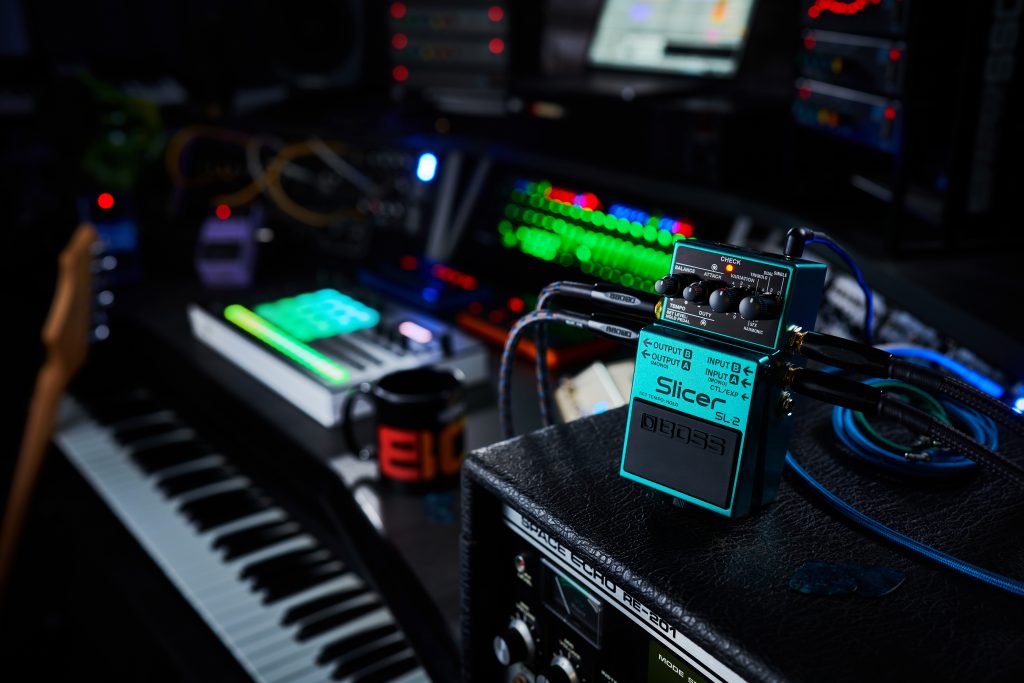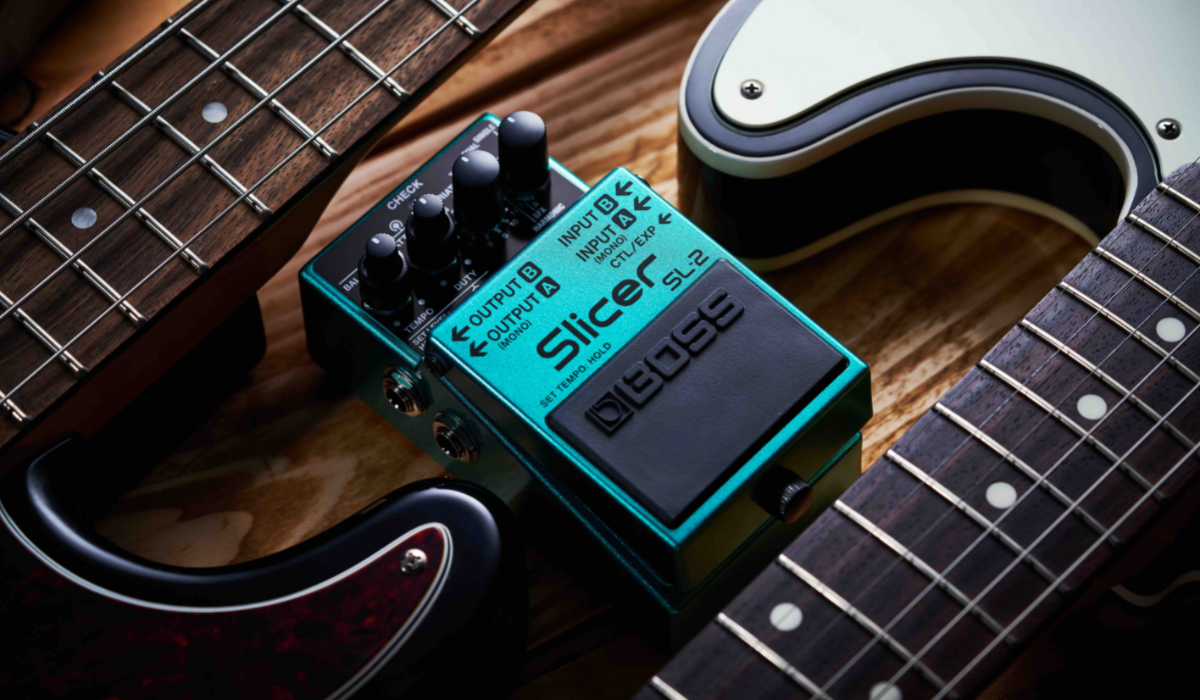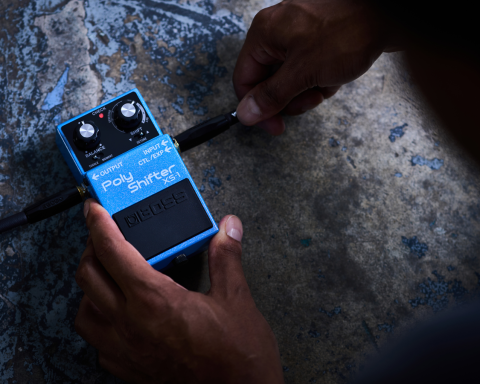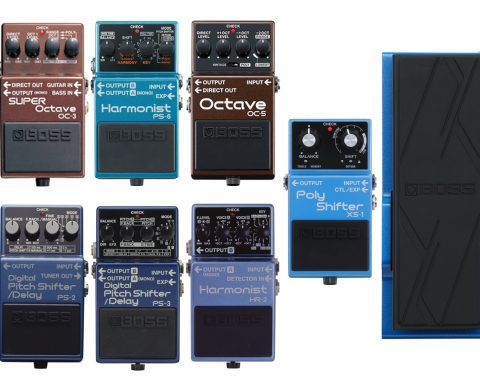For a fresh spark of musical inspiration, take the Slicer effect for a spin. Available in the standalone SL-2 compact pedal and as a built-in effect in lots of BOSS and Roland gear, this percolating wonder is truly unique. It chops up anything you feed into it, producing driving grooves and colorful rhythmic textures that will instantly get your creative juices flowing. Read on to learn more about this secret weapon used by Johnny Marr, Noel Gallagher, Omar Rodríguez-López, Jamie West-Oram, and other modern guitar innovators.
What is the Slicer?
The Slicer has its roots in tremolo, one of the first popular electronic effects for musicians. Tremolo modulates the input signal’s amplitude at a variable rate, acting as a pulsating volume control. The first tremolo units date back to the 1940s and were used with the earliest electric pianos. Soon after, as the electric guitar grew in popularity, tremolo started to appear as a standard effect in instrument amplifiers. Perhaps no example is more prominent than the misnamed “vibrato” found in classic ’50s and ’60s Fender models.
"Going beyond the tremolo's soulful steady throb, the Slicer uses step sequencing and precision digital clocking to produce an array of selectable rhythmic patterns."
The Slicer was first developed by BOSS and its parent company Roland in the late 1990s. Going beyond the tremolo’s soulful steady throb, it uses step sequencing and precision digital clocking to produce an array of selectable rhythmic patterns. This greatly expands on the creative potential of its original inspiration, delivering a sophisticated and controllable pulse that elevates any sound with intense grooving energy.
Among its earliest appearances, the Slicer was included in the Roland MC-505 GROOVEBOX in 1998 and the BOSS GT-3 guitar processor in 1999. In various forms, the Slicer has been part of the effects arsenal in many Roland and BOSS products ever since.
Pattern Tremolo on Steroids
In 2008, BOSS took the Slicer concept to another dimension with the SL-20 Slicer pedal. Leveraging the expanded size of the Twin Pedal format, BOSS engineers imbued this standalone Slicer with additional electronic capabilities that were impossible in a smaller pedal at the time.
The SL-20 featured Attack and Duty knobs for direct control over the waveform characteristics of the Slicer effect. It also had 50 onboard patterns, including many with filter effects to add color and movement. Numerous stereo output options were available too, with panning and 3D spatial processing producing impressive sounds that danced around the sound field. And with MIDI clock, users could synchronize the SL-20 to drum machines and other external sources to infuse any style with impressive tempo-synced vibes.
"Born in an era when electronic music and groove-focused music production were beginning to take over the mainstream, the SL-20 was a little ahead of its time."
Born in an era when electronic music and groove-focused music production were beginning to take over the mainstream, the SL-20 was a little ahead of its time. Still, it found a devoted following among adventurous music makers. Discontinued in 2018, the SL-20 remains a cult favorite that’s highly sought after on the used market.
Return of the Slicer Pedal
Introduced in late 2022, the SL-2 Slicer brings the groove-generating magic of the Slicer to a new generation of guitarists and creative musicians. Thanks to modern DSP, BOSS could put all the core features of the SL-20 into a pedalboard-friendly compact pedal—and go much further.
To start with, the sound quality received an upgrade to 48 kHz/32-bit processing. There are 88 onboard patterns to choose from, many colored with multiple internal effects. And with BOSS Tone Studio, you can replace the internal patterns with new selections and organize setups for different compositions.
"There are 88 onboard patterns to choose from, many colored with multiple internal effects."
All six of the SL-20’s stereo output modes are available in the SL-2, plus a new mode for sending direct and Slicer sounds to different amps or recording channels. And with up to +/- 12 dB of variable gain for the effect sound, you get much-improved effect/direct balance control (a frequent request from SL-20 users).
The SL-2 features a space-saving TRS MIDI input for perfect synchronization with drum machines and DAWs. The pedal’s MIDI spec goes further than the SL-20, allowing users to control tap tempo, level, and bypass via CC messages. Hardware control has been expanded as well with many assignable options for an external footswitch or expression pedal.

A Slicer by Any Other Name
Different versions of the Slicer effect come in other current BOSS and Roland products, each with a varying range of parameters to tweak. You can find the Slicer in the BOSS MD-500 and MD-200 modulation pedals, the GT-1000 and GT-1000CORE multi-effects processors, and higher-end RC Loop Station models to chop up loops in real time. It’s also included in the MFX sections of many Roland synths, SP samplers, and GROOVEBOX products.
Studio Applications
While the Slicer is great for performing with guitar and other instruments, it’s also a powerful tool for modern studio production. Try treating vocals, synthesizers, and complete tracks to unlock a universe of heretofore-unheard tones. Dynamic and distinctive, the Slicer rewards experimentation and sonic exploration.
INSPIRATION ZONE
It’s impossible to capture how cool the Slicer is in words. Check out these videos that feature the SL-2 pedal, where diverse players explore the effect’s enormous creative potential.
McRocklin
The incomparable guitar shredder and SL-2 pattern creator runs through the pedal’s features. In addition, McRocklin shows how he uses the effect with gain sounds, external effects, and his DAW.
Nick Reinhart
The guitar effects adventurer and math rock wizard from Tera Melos unboxes the SL-2 and dives deep into sound mangling with synth guitar tones and reverb.
Jorb Loves Gear
YouTube gear explorer Jorb runs through a brief Slicer history and puts the SL-2 through its paces with a vintage Roland JUNO-106 analog synth and the modern TR-8S Rhythm Performer.
Pedalboard of the Day
Check out this no-talk presentation using the SL-2 to process SY-1 synth guitar sounds, plus clean and fuzzy guitar tones.
Cyberattack
In this installment of his “How to Be Advanced” series, Cyberattack details the SL-2’s powerful Attack and Duty controls. He then shares five tips for using the Slicer in different musical applications.







